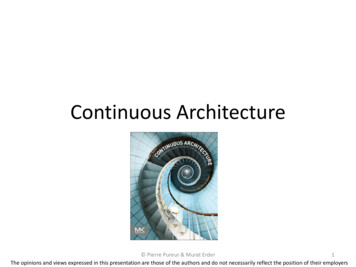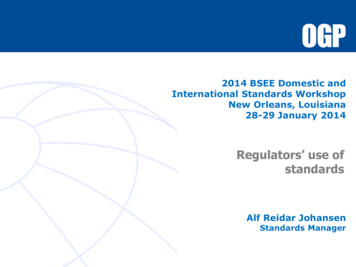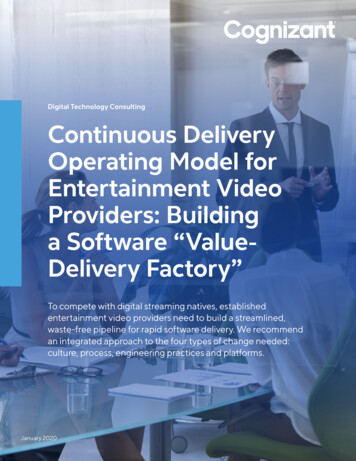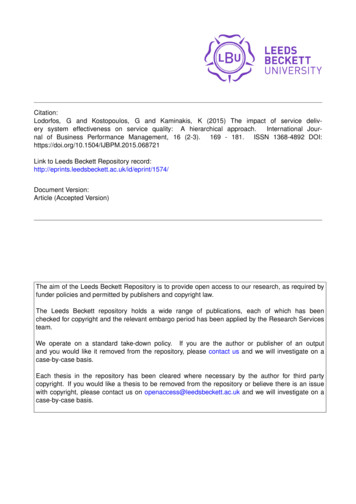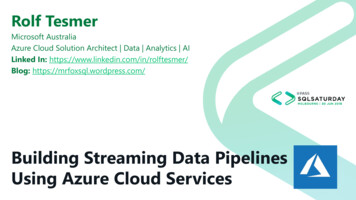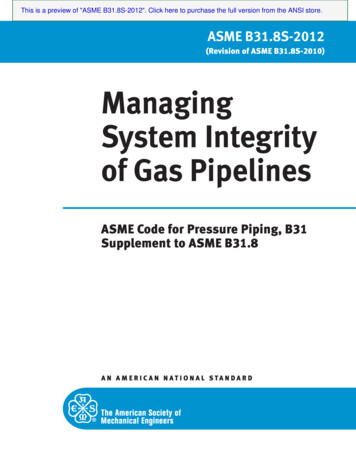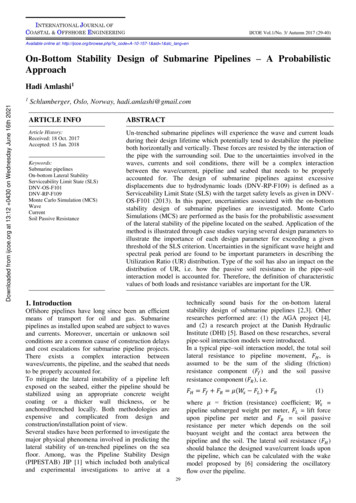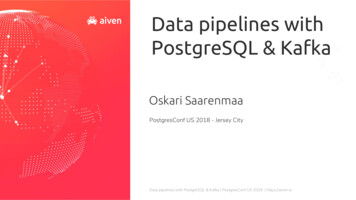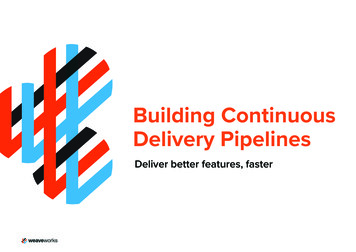
Transcription
Building ContinuousDelivery PipelinesDeliver better features, fastereBook 1
Table of ContentsCI/CD - Continuous Integration, Continuous Delivery and Continuous Deployment04Benefits of an Automated CI/CD Pipeline08Start Your Automation Journey10Understanding Production Ready12Best Practices for Continuous Delivery18CI/CD and Your Business23eBook 2
Building Continuous Delivery PipelinesA continuously automated flow of features is what distinguishes DevOps from other software development philosophies andpractices, unlike the waterfall model where development follows an orderly sequence of stages. Continuous of course means withoutinterruption, but that doesn’t mean your engineers are working 24/7 updating code, or that they are deploying updates every time aline of code is changed. Rather “continuous” refers to software changes and new features rolling out on a regular basis.By continuously pushing feature updates, businesses are more agile, can respond more quickly to customer demands and are morecompetitive in the marketplace.eBook 3
CI/CDContinuous Integration,Delivery and Deployment
CI/CD - Continuous IntegrationThe first step toward an automated pipeline is implementing ContinuousIntegration. With Continuous integration, developers are integrating smallchanges to the code base on a regular basis to ensure that their changehasn’t broken the build.When a developer commits a change to the code base, the CI systemautomatically builds and tests the changed code to make sure that it cansafely merge into the main branch. Performing this integration check eachtime a developer commits changes, maintains the integrity of the code baseand also minimizes the chance of a breaking change.Click here for moreinformation on“CI/CD for Kubernetes:What You Need to Know.”eBook 5
Continuous Delivery vs. Continuous DeploymentContinuous delivery takes the idea of continuous integration one step further and advances automation alongthe pipeline. With continuous delivery, code is not only integrated with changes on a regular basis, but as asecond stage it is also deployed to a given environment, such as staging or production.Some teams use the term “continuous delivery” interchangeably with the similar DevOps term “continuousdeployment.” The difference between the two terms is subtle but important. Continuous delivery means that theupdated code base is available to move onto the next development stage, whether that be staging, user review,or production.Continuous deployment is a natural progression of continuous delivery. Once all software changes passautomated and functional testing, as well as the build stages, they are automatically deployed to productionwithout human intervention. Continuously deploying code without human intervention is the goal that mostcompanies hope to achieve.eBook 6
METHODContinuousIntegrationUPFRONT COSTSWHAT YOU GAIN Unit tests need to be written for every newfunction and bug fix. Low level errors are caught early before theyhit production. An integration server to manage the tests andto integrate with the code base. An integrated code base that ensures thatthe build always works. Developers must check in code frequently. Developers are alerted early when the buildbreaks, resulting in less context-switching forthe team. Massive reduction in testing costs.ContinuousDelivery Integration tests must have good code basecoverage. Increases the number of releases andfeatures that you can deliver. Fully automated deployments without humanintervention should be possible. Features are iterated on more quickly, basedon customer feedback, resulting in a moreeffective feedback loop. Embrace feature flags so that incompletefeatures don’t affect other developers on yourteam or customers in production.ContinuousDeployment Establish a good test process and haveconfidence in your automated test suites. Since every change triggers the deploymentpipeline, even faster releases are possible. Make feature flags central to your deploymentsso that your company can easily co-ordinatenew requests. Releases are done in small batches socustomers see improvements on a daily basisrather than quarterly or monthly. Other processes in the company need to keepup with the rapid pace of deployments.eBook 7
BENEFITS OFAN AUTOMATEDCI/CD PIPELINE
There Are a Number of Benefitsto Automating Your CI/CD PipelineIncreased SpeedReduced Risks and CostsReduce your time to market from weeks and months toAutomation encourages developers to verify code changesdays or hours. With an automated pipeline, developmentin stages before moving forward, reducing the chances ofteams improve both the velocity of releases as well asdefects ending up in production. Also with an automatedthe quality of the code. New features, improvementspipeline, deployments are more clearly decoupled fromand fixes are added continuously in small incrementsreleases. This allows changes to be tested in multiple waysresulting in a product with fewer defects, allowing youbefore they are deployed to production.to be more competitive.A Strong Development TeamLess Work in ProgressBecause all stages of the delivery pipeline are availableA CD pipeline provides a rapid feedback loop starting fromfor anyone on the team to examine, improve upon anddevelopment through to your customers and around theverify, a sense of ownership over the build is createdloop again. This iteration cycle not only helps you buildthat encourages strong teamwork and collaborationthe right product, but it allows developers to make productacross your entire organization. This results in betterimprovements more quickly and also leaves less workcommunication between employees.in-progress to linger.eBook 9
STARTYOURAUTOMATIONJOURNEY
Start Your Automation JourneyIntroducing continuous delivery into your organization requires thought and planning as well as team commitment and buy-in. The transition can’tbe made overnight and it involves a number of intermediate and incremental steps to shift away from your current development methodology.Depending on how far along you are on the Cloud Native journey and whether you are running a Kubernetes cluster on one of the public cloudproviders or on-premise in your own data centre, there are several approaches to consider and plan for before fully automating your pipeline.Start SmallA mistake made by many organizations is that they take on too much too soon. Implementing CD is not easy,so it is always better to start off with a small proof of concept project before going ahead and convertingyour whole development processes all at once.Analyze YourCurrent ProcessWrite up your current development process so that you can see which procedures need to change andwhich ones can be automated. You may find that you can leverage existing CI tools that you already have inplace and build out an automated pipeline from that.Create anOpen CultureCreate transparency around the process of automation. Allow developers to make mistakes, so that gapsin the process can be addressed and corrected. This is also true once you’ve achieved automation wheredevelopers should have full ownership over the pipeline. In case a test fails, it should be possible to rollback quickly.Apply GitOpsPrinciplesWith ‘declarative infrastructure’ like Kubernetes cluster configuration, infrastructure can be kept in Gitalongside your code. This not only means that there is a ‘source of truth’ for both your infrastructure andapplication code, but that when disaster strikes, your infrastructure can be quickly restored from Git. Wediscuss GitOps in more detail further on in this document.MeasureYour SuccessDefine success metrics before you begin the transition to CD automation. It will allow you to consistentlyanalyze your progress and help refining where necessary.Step 1Step 2Step 3Step 4Step 5eBook 11
UNDERSTANDINGPRODUCTIONREADY
Understanding Production ReadyA Continuous Delivery pipeline involves a number of stages — coding, commiting the code to source control, unit testing andintegration, building and then deployment to production. Between each of these stages, code typically goes through manydifferent suites of automated tests before the new feature lands in production.A typical CI/CD pipeline for KuberneteseBook 13
3 Steps From Git To ProductionThe pipeline starts by the developer checking in code into Git which kicks off the CI tool. ThisSTAGE 1consists of running some unit tests and integrating the changes into the rest of the code basebefore it builds a Docker image. This stage of the pipeline provides the first indicator of “health” ofContinuous Integrationand Buildthe new code.With the Docker container in a registry, the newly built container image runs through a series ofSTAGE 2automated tests: functional, security, compliance or performance. These tests provide furtherverification stages for the code change. And until you’ve achieved full automation, and you areDeploymentAutomationconfident in your tests and the process, some of these verification stages may need some humanintervention.This is the final stage of the pipeline where the fully tested, and verified Docker image is deployedSTAGE 3to a staging environment. At this point the change may be deployed to a subset of your productionenvironment and initially monitored or it can undergo further user testing before being fully rolledTest Automationand Verificationout and released into production.eBook 14
Deployments vs. ReleasesAn important distinction to be aware of is the difference between a deployment and a release. A deployment is when softwarehas been tested and installed into a particular environment; whereas, a release is when those changes actually get into thehands of your end-users. Adding a deployment stage before you release to your customers allows you to do smoke tests, ormore advanced testing like blue-green deployments, canary or A/B testing or you may want to deploy with feature flags.SMOKE TEST: This test is essential if you want to ensure that the deployment was successful, and inparticular to test that your configuration settings for the production environment are set up correctly.BGBLUE-GREEN DEPLOYMENTS: This occurs when you run two identical deployments in parallel: one onproduction and another on a staging server. Final testing is done on one server and after testing, the liveserver is switched over from the tested version. If you need to rollback at a later point, this deploymentstrategy allows you to do that quickly and without any downtime.CANARY DEPLOYMENTS: This is useful when you want to test out a new feature with a subset of users.Similar to a blue-green deployment, you might have two almost identical servers: one that goes to all usersand another with the new features that gets rolled out to only a subset of users. These types of deploymentsallow you to test new features with a trusted group of users to ensure that you’re building the right product.A BvA/B TESTING: This is a form of user testing where you compare two different layouts or designs on a subsetof users to see which is the most effective for your use case.FEATURE FLAGS: These are used when a feature may have passed the unit tests in the integration phasebut is not fully complete. When a feature flag is turned on, it effectively hides it from the rest of the build.This allows the rest of the development team to release other complete features, without holding up adeployment or affecting customers in production.eBook 15
RollbacksThe goal is to be able to deploy a new change and get that changeinto the hands of your customers as quickly as possible. But equallyimportant is that when defects are found, you can rollback the changeso that it can be fixed. Rollbacks allow your team to more quicklyiterate back and forth across the pipeline with feedback received via afailed test or from a customer or other stakeholder. At any point in thepipeline, developers must be able to smoothly rollback a change andget back to a stable state.By implementing rollbacks, you and your team can benefit fromincreased confidence and speeding up your feedback loop.eBook 16
Five Key Performance Indicators (KPIs) for Success1Deployment orCycle Time2DeploymentFrequency3ChangeLead Time4ChangeFailure Rate5MTTR vs. MTTFA term borrowed from manufacturing, “cycle time” is the time it takes for a feature to go from build to production.By measuring the phases of your development process, for example, coding, review process, test and release toproduction, the average cycle time is obtained. This metric provides insight into the bottlenecks in your process andthe overall speed or time to deployment.Not only do more frequent deployments give you an opportunity to improve upon your software, but by measuringfrequency, it allows you to analyze any bottlenecks you may find during your automation journey. The general rule isthat more frequent smaller releases reduces the risk of defects, and maybe more importantly, increases the ability tofix them when found. This metric is an overall measure of your team’s efficiency and cohesiveness.Measures the start of development to deployment. Like deployment frequency, this metric is also an indicatorof your entire development process and how well your team works together. If the lead time is too long, it maysuggest bottlenecks in your process or that your code and development systems are overly complicated.This metric focuses on the number of times your deployment was successful versus the number of times thedeployment failed. This metric is one that should decrease over time. It is generally a useful measure of the successof your DevOps process.The Mean Time to Recovery (MTTR) is the amount of time it takes for your team to recover from a failure; either acritical bug or a complete system failure. The Mean Time to Failure (MTTF) on the other hand measures the amountof time between fixes or outages. Both metrics are a reflection of your team’s ability to respond and fix problems.Generally you will want to see a downward trend for these metrics.eBook 17
BEST PRACTICESFOR CONTINUOUSDELIVERY
Best Practices for Continuous DeliveryWhen you’re ready to start putting the components together for yourautomated pipeline, you’ll need to select the right tools for your team. Let’sreview a couple of best practices when it comes to Mean Time to Recovery(MTTR) and security.Reduced Mean Time to Recovery with GitOpsGit enables declarative tools and for optimized Mean Time to Recovery (MTTR),you should implement GitOps.GitOps works by using Git as a single source of truth for declarative infrastructureand applications within your entire system. Automated delivery pipelines roll outchanges to your infrastructure when changes are made to Git.For more on GitOpsSee “Operations by Pull Request” and“GitOps: High velocity CICD for Kubernetes”.Not only is there a ‘source of truth’ for both your infrastructure and application code,but when disaster strikes, infrastructure can be quickly and easily restored from Git,reducing your MTTR from hours to minutes.eBook 19
Best Practices for Continuous Delivery (cont’)Securing Your PipelinePush PipelinesMost of the CI/CD tools available today use a push-based model. This meansthat code goes through the pipeline starting with the CI system and continuesits path through a series of encoded scripts or by manually pushing changesto the Kubernetes cluster.Push Type Patterns Can be InsecureThe reason you don’t want to use your CI system as the deployment catalystor do it manually on the command line is because of the potential to exposecredentials outside of your cluster. While it is possible to make thoseinteractions secure in both your CI/CD scripts and manually on the commandline, you are working outside the trust domain of the cluster. This is generallynot good practice and is why CI systems can be known as attack vectors forproduction.eBook 20
Best Practices for Continuous Delivery (cont’)Pull Pipelines and Weave CloudOur product Weave Cloud, is a management and operations platform for containers. It uses a pull strategy and consistsof two key components: a Deployment Automator that watches the image registry and a Deployment Synchronizer in thecluster to maintain its state.At the centre of our pull pipeline pattern is Git (orA pull pipeline for CI/CDany source control repo) that not only versions code,but also provides the single source of truth for thePullnt AutomeloypDematorKubernetes manifests. Developers push their updatedcode to the code base repository; where the changeWrite CodeContainerRegistryis picked up by the CI tool, tests are run and a Dockerimage is built and uploaded to an image repository.This is where Weave Cloud’s deployment featurescome into play. The deployment automator watchesCI Test BuildContainerthe image repository for new Docker containers, andwhen it sees one, it updates the manifest file in Git andautomatically deploys the new image to the cluster.VCSCode BaseKubernetes ClusterCIContinuous IntegrationCDContinuous Delivery/DeploymenteBook 21
Best Practices for Continuous Delivery (cont’)The Benefits of a Pull-Based Pipeline CI is decoupled from CD, and therefore the CI tool doesn’t haveelevated access to your cluster. Secure cluster credentials alwaysremain with the cluster and are not widely shared across thepipeline or teams. Deployment policies can be set and changed (automatic or manual)in one place instead of keeping them scattered across your CIpipelines and embedded in custom scripts. Since all Kubernetes manifests are versioned in Git, if yourcluster ever goes down, developers can restore everything andrecover in minutes. Keeping manifests in Git also means that clusterconfiguration is always in-sync with what’s being kept in Git.eBook 22
CI/CDANDYOURBUSINESS
CI/CD and Your BusinessAchieving automated Continuous Delivery within your organization is not easy. The biggests hurdles you’re likely to face are thecultural shifts that will need to be made within your organization to make the successful transition. Everyone within your company willbe stakeholders in the new “Continuous Software” paradigm.DevOps New Ops TeamCultural Impacts of CDOne of the biggest misconceptions that some companies makeThe success of DevOps depends a lot on company culture.is that they feel they need to create a ‘DevOps team’ that willInternal teams must be able to adopt cross-functional methodsimplement and enforce best practices. For example, you don’tto ensure that software is iterated on with a continuous cadencewant to transform your Ops team into the DevOps team. Instead,but also complements the marketing and business goals of theyou want your Ops team to assist with the tools so that developerscompany. Making the actual switch to continuous delivery maycan be self-sufficient in their ability to deploy applications safelybe the easiest part in your company; getting those changes toand securely to your cluster.stick and also propagating them throughout your organization isprobably the most difficult part of the process.DevOps is less about forming yet another silo and is more aboutadopting a new philosophical approach to software development.eBook 24
Culture and Your Journey toAutomatic Continuous DeliveryTransparencyCollaborationEveryone on the team should know how to fix or rollbackFollowing on the notion of transparency, it’s also importanta build, allowing them to take responsibility for the buildthat when the pipeline breaks or if a bug is found, thatand not leave it to one particular team. Creating cross-teams can effectively work together to figure out the bestfunctional teams throughout your organization ensuresperson to make the fix.that everyone has a stake in the outcome and new ideasare encouraged.OwnershipWhile collaboration is important, it is equally importantCreate a No Blame Atmospherethat developers take full ownership over their production-Allow developers to make mistakes, so that gaps in theready code. This is the DevOps mantra that says, ‘youprocess can be addressed and corrected. Transitioning tobuild it, you run it’ and it means that developers shouldcontinuous delivery can be challenging, you need to givenot have to rely on Ops or any other team to deployyour team the space to experiment and to fail before theytheir changes. The automation pipeline must be able towill be successful.accommodate developers deploying code to clusterssafely and securely.eBook 25
About WeaveworksWeaveworks makes it fast and simple for developers to build and operatecontainerized applications. The Weave Cloud operations-as-a-service platformprovides a continuous delivery pipeline for building and operating applications,letting teams connect, monitor and manage microservices and containerson any server or public cloud. Weaveworks also contributes to several opensource projects, including Weave Scope, Weave Cortex, and Weave Flux. It wasone of the first members of the Cloud Native Computing Foundation. Foundedin 2014, the company is backed by Google Ventures and Accel Partners andothers.Sign up today for a free 30 day trial for Weave Cloud.Weaveworks now offers Production Grade Kubernetes Support forenterprises. For the past 3 years, Kubernetes has been powering Weave Cloud,our operations as a service offering, so we couldn’t be more excited to shareour knowledge and help teams embrace the benefits of cloud native tooling.Contact us for more information.eBook 26
2018 Weaveworks, Inc. All rights reserved.eBook 26
Continuous Delivery vs. Continuous Deployment Continuous delivery takes the idea of continuous integration one step further and advances automation along the pipeline. With continuous delivery, code is not only integrated with changes on a regular basis, but as a second stage it is als
